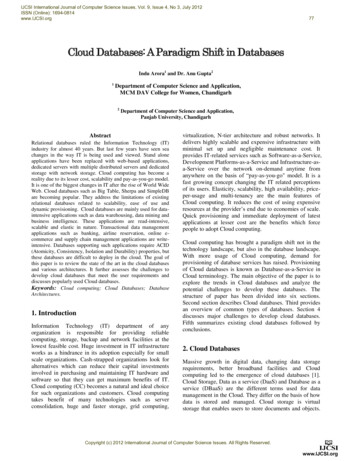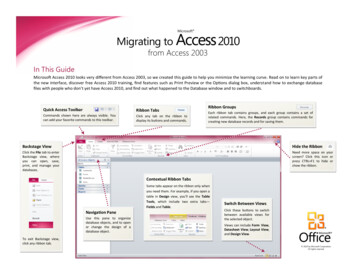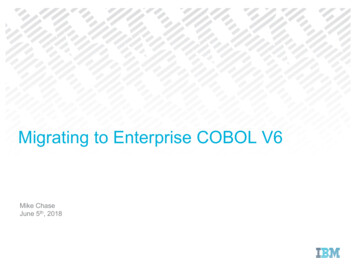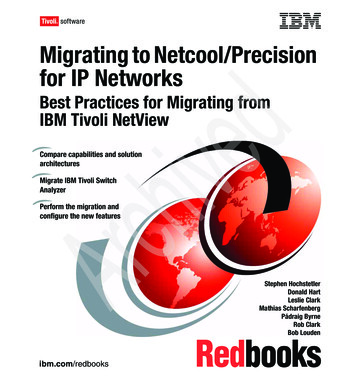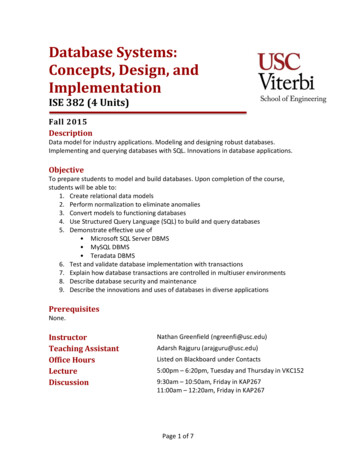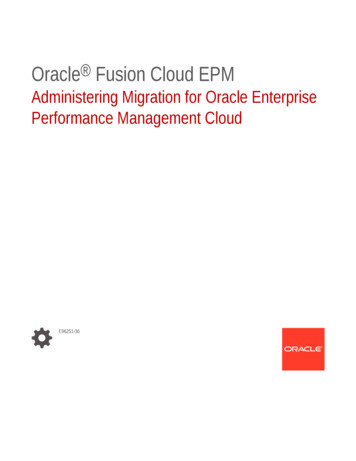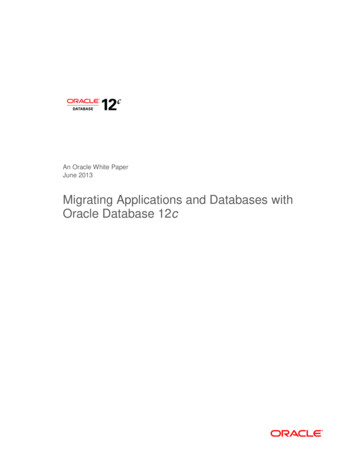
Transcription
An Oracle White PaperJune 2013Migrating Applications and Databases withOracle Database 12c
Oracle White Paper— Application Development with Oracle Database 12cDisclaimerThe following is intended to outline our general product direction. It is intended for information purposesonly, and may not be incorporated into any contract. It is not a commitment to deliver any material, code, orfunctionality, and should not be relied upon in making purchasing decisions. The development, release, andtiming of any features or functionality described for Oracle’s products remains at the sole discretion ofOracle.
Oracle White Paper— Application Development with Oracle Database 12cIntroduction . 1Oracle SQL Developer . 2Introduction. 2Oracle Database 12c Application Migration Enhancements. 3Introduction. 3Identify Columns . 332K VARCHAR2’s . 3FETCH FIRST ROWS . 4Implicit Cursors . 5Oracle Multitenant . 6SQL Translation Framework . 7Introduction. 7Conclusion . 9
Oracle White Paper— Application Development with Oracle Database 12cIntroductionMigrating applications and data from one database to another is often a high-risk, expensive,and time-consuming process. However, Oracle provides products that reduce the time, risk,and financial barriers involved in migrating non-Oracle databases to the Oracle platform.Oracle Database 12c introduces significant new features designed to lower the cost and timerequired to migrate non-Oracle database to the Oracle platform. These features include:enhanced SQL Developer, enhanced SQL Developer Migration Workbench, auto-incrementIDENTITY columns, Implicit Result Sets, 32K VARCHARs, SQLTranslation Framework, Driverfor MySQL Applications, and FETCH FIRST ROWS. This white paper outlines the newdatabase features which assist in migrations.1
Oracle White Paper— Application Development with Oracle Database 12cOracle SQL DeveloperIntroductionIncluded with Oracle Database 12c is Oracle SQL Developer. SQL Developer is a graphical tool thatenhances productivity and simplifies database development tasks. Using SQL Developer, users canbrowse, create and modify database objects, run SQL statements, edit and debug PL/SQL and haveaccess to an extensive list of predefined reports or create their own.Oracle SQL Developer is also the primary third-party database migration platform for Oracle database.Oracle SQL Developer provides an integrated migration tool for migrating Microsoft SQL Server,Sybase, MySQL, Microsoft Access, IBM DB2 LUW and Teradata to Oracle Database.With SQL Developer, users can create connections to non-Oracle databases for object and databrowsing. Once a connection is created, the tool provides utilities to migrate any of these databases toOracle. Depending on the database in question, SQL Developer automatically converts the tables,triggers, stored procedures and all other relevant objects to an Oracle database. Once the target Oracledatabase has been generated, SQL Developer assists in the migration of the data from the non-Oracledatabase to the target Oracle database.When the target database for an Oracle database migration is version 12c, Oracle SQL Developer willautomatically migrate the objects and stored procedures using the new database 12c features discussedbelow. Included in the descriptions are some examples of how the code or objects are migrated toOracle in 11g and older databases versus going forward in 12c and newer databases.2
Oracle White Paper— Application Development with Oracle Database 12cOracle Database 12c Application Migration EnhancementsIntroductionThe following new features directly address the challenges our customers face when planningmigrations to Oracle database. This white paper will provide a brief description and example of each ofthe following features: Identity Columns 32k Varchar2s FETCH FIRST rows (SQL) Implicit Cursors Oracle Multitenant SQL Translation Framework Driver for MySQL ApplicationsEach of these features will dramatically decrease the amount of work required to migrate yourapplications to Oracle Database, thus saving you time and money.Identify ColumnsPrimary key constraints define a table column or columns that will serve to uniquely identify records inthat table. A common programming technique is to have a value automatically generated and assignedas rows in a table are generated and inserted. In prior versions of Oracle Database, this was frequentlyaccomplished by creating a SEQUENCE and a TRIGGER. The sequence would define the values tobe generated, and the trigger would fire on an insert and would feed the value of the sequence to thetable.In other third party relational database management systems this can also be accomplished by using anIdentity column. This allows the sequence logic to be directly embedded into the definition of thetable, bypassing the need to create a sequence and a trigger to handle the generation and population ofthe primary key value of the table records.This represents significant cost savings for customers migrating to Oracle Database. Instead of havingto generate two additional database objects for each table making use of an identify column, this cannow be defined in the table itself. This also lowers the cost of maintenance going forward as there arefewer database objects to manage and support.Fewer objects, less code, less work – all handled automatically when migrating to Oracle Database 12cusing Oracle SQL Developer.32K VARCHAR2’sSince its introduction, the VARCHAR2 datatypes ((including VARCHAR2, NVARCHAR2, and RAW)have had a max size of 4,000 bytes, which equates to 4,000 characters in single byte charactersets.3
Oracle White Paper— Application Development with Oracle Database 12cTable column definitions exceeding this size would be migrated as CLOBs or BLOBs. This presented achallenge for many customers migrating from non-Oracle database environments as other third partydatabases supported much larger strings in their native datatypes. With the introduction of OracleDatabase 12c, VARCHAR2, NVARCHAR2, and RAW now supports up to 32,768 bytes.CLOBs can present optimization and flexibility challenges for developers. Offering an extended sizeVARCHAR2 means that in most cases migrations can continue with no requirement to switch toCLOBs in the column definition for tables containing large strings. In addition, indexes can be built ontop of such columns, unlike CLOBS or BLOBS.The default Oracle Database 12c parameters must be updated to allow the new 32k VARCHAR2 size.To enable the increased size limits for these datatypes, the following database parameters are required:MAX SQL STRING SIZE controls the maximum size of the extended data types in SQL, where:LEGACY means the length limit of the data types used prior to Oracle 12c.EXTENDED means the 32767 bytes limit in Oracle Database 12c.You must set the COMPATIBLE initialization parameter to 12.0.0.0 or higher to setMAX SQL STRING SIZE EXTENDED.FETCH FIRST ROWSQueries that order data and then limit row output are widely used and are often referred to as Top-Nqueries. Prior to Oracle Database 12c, developers would attempt to implement this ANSI SQL featureusing the pseudo-column ‘ROWNUM’ to limit the number of rows returned in a query.In Oracle Database 12c Release 1, SQL SELECT syntax has been enhanced to allow arow limiting clause, which limits the number of rows that are returned in the result set. Therow limiting clause provides both easy-to-understand syntax and expressive power. Limiting thenumber of rows returned can be valuable for reporting, analysis, data browsing, and other tasks.4
Oracle White Paper— Application Development with Oracle Database 12cYou can specify the number of rows or percentage of rows to return with the FETCH FIRSTkeywords. You can use the OFFSET keyword to specify that the returned rows begin with a row afterthe first row of the full result set. The WITH TIES keywords includes rows with the same orderingkeys as the last row of the row-limited result set (you must specify ORDER BY in the query).The row limiting clause follows the ANSI SQL international standard for enhanced compatibility andeasier migration.The new FETCH FIRST SQL is powerful and easy to read.Implicit CursorsA common programming practice in Microsoft SQL Server and SAP’s Sybase ASE database’sextended SQL language, T-SQL, is to write SQL statements directly in their stored procedures. Callingthese stored procedures would make the resultset for the one or more queries immediately available tothe calling user or program.Prior to Oracle Database 12c, migrating these stored procedures to Oracle Database PL/SQLequivalent procedures would require changing the procedure header to include one or moreSYS REFCURSORs as OUT or RETURN parameters, then subsequently retrieve the result sets viathe Ref Cursors.5
Oracle White Paper— Application Development with Oracle Database 12cWith Oracle Database 12c, stored procedures can use the DBMS SQL package’sRETURN RESULT() function to make the query results available to the calling user or program.JDBC ExampleNew Oracle JDBC methodsgetMoreResults() or getMoreResults(int): checks if there are more results available in the result set.The int parameter that can have one of the following values:KEEP CURRENT RESULT, CLOSE ALL RESULTS, CLOSE CURRENT RESULTgetResultSet(): iteratively retrieves each implicit resultThe following Java code migrated from a third-party database will work with Oracle Database withoutany changesCallableStatement cstmt null;ResultSet rs null;cstmt conn.prepareCall(“{call testproc1()}”);cstmt.execute();boolean resultsAvailable cstmt.getMoreResults();Oracle MultitenantWith Oracle database 12c, multitenancy for applications can now be achieved at the database level withOracle Multitenant. A single Oracle Database 12c Container Database (CDB) can service one or morePluggable Databases (PDBs). Instead of migrating multiple third-party databases to a single OracleDatabase using schemas as a ‘container’ for each migrated database, Oracle Database 12c now allowsfor individual PDBs to be used.6
Oracle White Paper— Application Development with Oracle Database 12cSQL Translation FrameworkIntroductionWhile migrating database objects and data is a major undertaking, migrating database applications is noless critical or time consuming. Each of the relational database management systems has its ownimplementation of the SQL standard. SQL that may run in Sybase ASE may not run in Oracledatabase. The amount of custom SQL present in an application can largely define the amount of timerequired to fully migrate a database and its applications.Database application migrations are assisted by Oracle SQL Developer and its application scannerscripts. SQL Developer can parse and document SQL statements that require translation beforerunning against an Oracle Database. The task of doing the actual translations is left to the end user, orcan be attempted one at a time using SQL Developer’s SQL Translation Scratch Editor.The SQL Translation Scratch editor is an ad hoc translation engine that allows users to connect to 3rdparty databases, run their SQL statements, translate them to Oracle, run the statements again in OracleDatabase, and compare the results. Developers can then manually update their applications to run themodified code. This works fine for static SQL, but there is no solution for dynamically generated SQLstatements.This time consuming and error-prone process has been greatly enhanced with the introduction of theSQL Translation Framework in Oracle 12c. The framework allows for the translators in Oracle SQLDeveloper to be loaded directly into the database as a collection of Java stored classes and procedures.Available with Oracle Database 12c are translators for Sybase ASE and SQL Server.Once installed from SQL Developer to the database, the translator can be activated at the session orservice level. Statements sent to the database will be parsed as non-Oracle SQL, translated, andexecuted. A collection of these translations are stored in a SQL Translation Profile. The contents ofthe profile can be reviewed, modified, and approved by the migration team to ensure the translationsare accurate. Profiles can be created for each application to be migrated and can then be transferredbetween databases so that the translations are transportable.SQL Translation Framework Workflow1.Framework receives SQL call2.Performs lookup in SQL translation dictionary (Profile)3.When not found it fingerprints the statement and adds it to the dictionary4.It then processes the template with the values suppliedAn Example Framework receivesSELECT TOP 2 * FROM T1 Performs static lookup of a conversion in the SQL Translation Dictionary7
Oracle White Paper— Application Development with Oracle Database 12c Not Available: Generate the Fingerprint Select Top ora:literal type integer order 1 * From T1Note: literals are mapped in translations such that ‘select 1; select 2 select 3;’ are treated as asingle statement, where the literal (1, 2, or 3) is stored as ora:literal type integer order 1 )in the Fingerprint. Lookup fingerprint in the SQL Translation DictionaryAvailable: Gets the FingerprintSelect * From T1 FETCH FIRST ora:literal type integer order 1 ROWS ONLY Processes the Template with values acquiredSelect * From T1 FETCH FIRST 2 ROWS ONLY Returns the translated SQL to the Framework SQL Translation Framework handles binds if necessarySQL Translation Framework Diagram: A Sybase application connects to Oracle and runs, having its statementstranslated and executed on-the-fly for Oracle.8
Oracle White Paper— Application Development with Oracle Database 12cConclusionOracle Database 12c helps customers lower IT costs and delivers a higher quality service by enablingconsolidation onto database clouds and engineered systems like Oracle Exadata and Oracle DatabaseAppliance. It’s proven to be fast, reliable, secure and easy to manage for all types of databaseworkloads including enterprise applications, data warehouses and bid data analysis.Moving your database and database powered applications to Oracle Database often requires significantapplication and data model updates as non-Oracle technologies must be implemented to work withexisting Oracle structures, data types, proprietary SQL and procedural languages (PLSQL.) OracleDatabase 12c includes many new features which minimize database and application changes toaccommodate applications not originally developed for Oracle Database.9
Application Development withCopyright 2013, Oracle and/or its affiliates. All rights reserved. This document is provided for information purposes only and theOracle Database 12ccontents hereof are subject to change without notice. This document is not warranted to be error-free, nor subject to any otherJune 2013warranties or conditions, whether expressed orally or implied in law, including implied warranties and conditions of merchantability orAuthor: Jeff Smithfitness for a particular purpose. We specifically disclaim any liability with respect to this document and no contractual obligations areContributing Authors: Ashley Chen, Davidformed either directly or indirectly by this document. This document may not be reproduced or transmitted in any form or by anyGambino, Kuassi Mensahmeans, electronic or mechanical, for any purpose, without our prior written permission.Oracle CorporationWorld Headquarters500 Oracle ParkwayRedwood Shores, CA 94065U.S.A.Worldwide Inquiries:Phone: 1.650.506.7000Fax: 1.650.506.7200oracle.comOracle and Java are registered trademarks of Oracle and/or its affiliates. Other names may be trademarks of their respective owners.Intel and Intel Xeon are trademarks or registered trademarks of Intel Corporation. All SPARC trademarks are used under license andare trademarks or registered trademarks of SPARC International, Inc. AMD, Opteron, the AMD logo, and the AMD Opteron logo aretrademarks or registered trademarks of Advanced Micro Devices. UNIX is a registered trademark of The Open Group. 0612
Oracle SQL Developer is also the primary third-party database migration platform for Oracle database. Oracle SQL Developer provides an integrated migration tool for migrating Microsoft SQL Server, Sybase, MySQL, Microsoft Access, IBM DB2 LUW and Teradata to Oracle Database. . Migrating Applications and Databases with Oracle Database 12c
